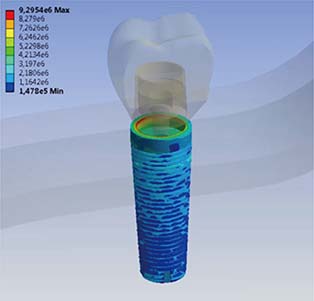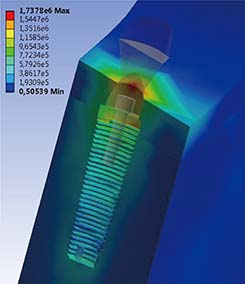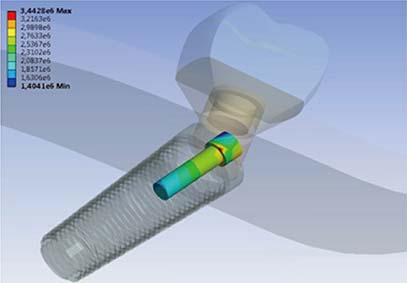J Adv Prosthodont.
2016 Apr;8(2):131-136. 10.4047/jap.2016.8.2.131.
Effects of crown retrieval on implants and the surrounding bone: a finite element analysis
- Affiliations
-
- 1Department of Prosthodontics, Faculty of Dentistry, Afyon Kocatepe University, Afyonkarahisar, Turkey. seozkir@aku.edu.tr
- 2Department of Prosthodontics, Faculty of Dentistry, Dicle University, Diyarbakir, Turkey.
- KMID: 2176653
- DOI: http://doi.org/10.4047/jap.2016.8.2.131
Abstract
- PURPOSE
The aim of this study was to observe stress concentration in the implant, the surrounding bone, and other components under the pull-out force during the crown removal.
MATERIALS AND METHODS
Two 3-dimensional models of implant-supported conventional metal ceramic crowns were digitally constructed. One model was designed as a vertically placed implant (3.7 mm × 10 mm) with a straight abutment, and the other model was designed as a 30-degree inclined implant (3.7 mm × 10 mm) with an angled abutment. A pull-out force of 40 N was applied to the crown. The stress values were calculated within the dental implant, the abutment, the abutment screw, and the surrounding bone.
RESULTS
The highest stress concentration was observed at the coronal portion of the straight implant (9.29 MPa). The stress concentrations at the cortical bone were lower than at the implants, and maximum stress concentration in bone structure was 1.73 MPa. At the abutment screws, the stress concentration levels were similiar (3.09 MPa and 3.44 MPa), but the localizations were different. The stress at the angled abutment was higher than the stress at the straight abutment.
CONCLUSION
The pull-out force, applied during a crown removal, did not show an evident effect in bone structure. The higher stress concentrations were mostly observed at the implant and the abutment collar. In addition, the abutment screw, which is the weakest part of an implant system, also showed stress concentrations. Implant angulation affected the stress concentration levels and localizations. CLINICAL IMPLICATIONS: These results will help clinicians understand the mechanical behavior of cement-retained implant-supported crowns during crown retrieval.
Keyword
Figure
Reference
-
1. Misch CE. Contemporary implant dentistry. 2nd ed. Mosby: St. Louis;1999. p. 3–12.2. Sheets JL, Wilcox C, Wilwerding T. Cement selection for cement-retained crown technique with dental implants. J Prosthodont. 2008; 17:92–96.3. Bulaqi HA, Mousavi Mashhadi M, Safari H, Samandari MM, Geramipanah F. Effect of increased crown height on stress distribution in short dental implant components and their surrounding bone: A finite element analysis. J Prosthet Dent. 2015; 113:548–557.4. Worni A, Gholami H, Marchand L, Katsoulis J, Mericske-Stern R, Enkling N. Retrievability of implant-supported crowns when using three different cements: a controlled clinical trial. Int J Prosthodont. 2015; 28:22–29.5. Assenza B, Scarano A, Leghissa G, Carusi G, Thams U, Roman FS, Piattelli A. Screw- vs cement-implant-retained restorations: an experimental study in the Beagle. Part 1. Screw and abutment loosening. J Oral Implantol. 2005; 31:242–246.6. Mehl C, Harder S, Wolfart M, Kern M, Wolfart S. Retrievability of implant-retained crowns following cementation. Clin Oral Implants Res. 2008; 19:1304–1311.7. Vohra F, Habib R. Knowledge and attitude of dentists toward implant retained restorations in Saudi Arabia. Niger J Clin Pract. 2015; 18:312–317.8. Chaar MS, Att W, Strub JR. Prosthetic outcome of cementretained implant-supported fixed dental restorations: a systematic review. J Oral Rehabil. 2011; 38:697–711.9. Heinemann F, Mundt T, Biffar R. Retrospective evaluation of temporary cemented, tooth and implant supported fixed partial dentures. J Craniomaxillofac Surg. 2006; 34:86–90.10. Kayabaşı O, Yüzbasıoğlu E, Erzincanlı F. Static, dynamic and fatigue behaviors of dental implant using finite element method. Adv Eng Softw. 2006; 37:649–658.11. Culhaoglu AK, Özkır SE, Celik G, Terzioglu H. Comparison of two different restoration materials and two different implant designs of implant-supported fixed cantilevered prostheses: A 3D finite element analysis. Eur J Gen Dent. 2013; 2:144–150.12. Kokubo Y, Kano T, Tsumita M, Sakurai S, Itayama A, Fukushima S. Retention of zirconia copings on zirconia implant abutments cemented with provisional luting agents. J Oral Rehabil. 2010; 37:48–53.13. Curtis DA, Plesh O, Sharma A, Finzen F. Complications associated with fixed partial dentures with a loose retainer. J Prosthet Dent. 2006; 96:245–251.14. Hill EE, Lott J. A clinically focused discussion of luting materials. Aust Dent J. 2011; 56:67–76.15. Michalakis K, Pissiotis AL, Kang K, Hirayama H, Garefis PD, Petridis H. The effect of thermal cycling and air abrasion on cement failure loads of 4 provisional luting agents used for the cementation of implant-supported fixed partial dentures. Int J Oral Maxillofac Implants. 2007; 22:569–574.16. Farzin M, Torabi K, Ahangari AH, Derafshi R. Effect of abutment modification and cement type on retention of cement-retained implant supported crowns. J Dent (Tehran). 2014; 11:256–262.17. Ozkir SE, Terzioglu H. Macro design effects on stress distribution around implants: a photoelastic stress analysis. Indian J Dent Res. 2012; 23:603–607.18. Martini AP, Barros RM, Júnior AC, Rocha EP, de Almeida EO, Ferraz CC, Pellegrin MC, Anchieta RB. Influence of platform and abutment angulation on peri-implant bone. A three-dimensional finite element stress analysis. J Oral Implantol. 2013; 39:663–669.19. Pan YH, Ramp LC, Lin CK, Liu PR. Comparison of 7 luting protocols and their effect on the retention and marginal leakage of a cement-retained dental implant restoration. Int J Oral Maxillofac Implants. 2006; 21:587–592.20. Mansour A, Ercoli C, Graser G, Tallents R, Moss M. Comparative evaluation of casting retention using the ITI solid abutment with six cements. Clin Oral Implants Res. 2002; 13:343–348.21. Achour T, Merdji A, Bachir Bouiadjra B, Serier B, Djebbar N. Stress distribution in dental implant with elastomeric stress barrier. Mater Des. 2011; 32:282–290.22. Wolff J, Narra N, Antalainen AK, Valášek J, Kaiser J, Sándor GK, Marcián P. Finite element analysis of bone loss around failing implants. Mater Des. 2014; 61:177–184.23. Göre E, Evlioğlu G. Assessment of the effect of two occlusal concepts for implant-supported fixed prostheses by finite element analysis in patients with bruxism. J Oral Implantol. 2014; 40:68–75.24. Akça K, Iplikçioğlu H. Evaluation of the effect of the residual bone angulation on implant-supported fixed prosthesis in mandibular posterior edentulism. Part II: 3-D finite element stress analysis. Implant Dent. 2001; 10:238–245.25. Gomes EA, Assunção WG, Barão VA, Delben JA, Rocha EP, de Sousa EA. Passivity versus unilateral angular misfit: evaluation of stress distribution on implant-supported single crowns: three-dimensional finite element analysis. J Craniofac Surg. 2010; 21:1683–1687.26. Frost HM. A 2003 update of bone physiology and Wolff ’s Law for clinicians. Angle Orthod. 2004; 74:3–15.27. de Moraes SL, Verri FR, Santiago JF Jr, Almeida DA, de Mello CC, Pellizzer EP. A 3-D finite element study of the influence of crown-implant ratio on stress distribution. Braz Dent J. 2013; 24:635–641.28. Elias CN, Oshida Y, Lima JH, Muller CA. Relationship between surface properties (roughness, wettability and morphology) of titanium and dental implant removal torque. J Mech Behav Biomed Mater. 2008; 1:234–242.
- Full Text Links
- Actions
-
Cited
- CITED
-
- Close
- Share
- Similar articles
-
- Stress distribution in bone surrounding maxillary molar implants under different crown-to-fixture ratio: A 3D FEM analysis
- Three-dimensional finite element analysis according to the insertion depth of an immediately loaded implant in the anterior maxilla
- Three-dimensional finite element analysis of implant-supported crown in fibula bone model
- The three dimensional finite element analysis of the stress distribution according to the thread designs and the marginal bone loss of the implants
- The effect of implant system with reverse beveled platform design on marginal bone stress distribution









